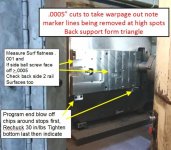lspotts38
Aluminum
- Joined
- Mar 7, 2012
- Location
- Northcentral Pennsylvania
I was posed the question today "The CNC's have probes in them, if we could get them certified, could we use them for inspection?". Simplification of the conversation, but pretty much covers the context of the question. I'm familiar with probing on the machines, use them a lot for setup, correct loading confirmation, and in process verification of machined features. Writing the cycles and outputting the results wouldn't be an issue. My initial thought was no way would I ever want to machine and inspect with the same machine, thought being that if the issue arose that there was a problem with machining, the possibility also exists that it could inspect it incorrectly as well. I overall don't think it is a good idea, but also am not ignorant to the machining movement would likely never be the same as the inspection movement, and the likelihood that the probing wouldn't show an issue that arose is probably small-ish. Consider also that the parts are fairly complex five axis pieces, with fairly tight positional/diameter tolerances. I don't particularly care for the concept, but don't want to be ignorant to the state of the art that I do not know about. Anybody out there inspecting on the machine tool?



